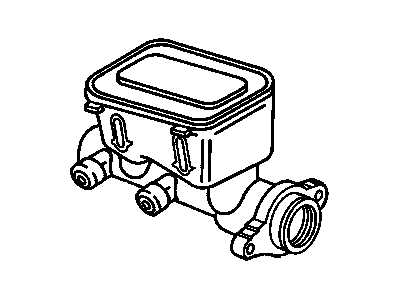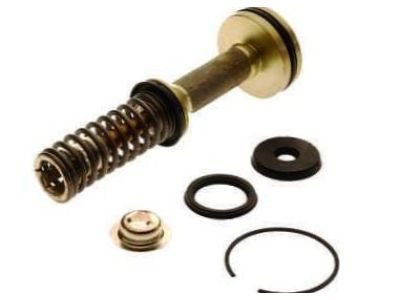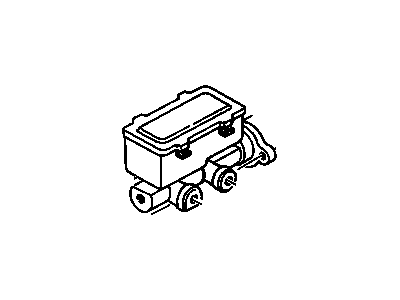My Garage
My Account
Cart
Genuine Chevrolet K1500 Brake Master Cylinder
- Select Vehicle by Model
- Select Vehicle by VIN
Select Vehicle by Model
orMake
Model
Year
Select Vehicle by VIN
For the most accurate results, select vehicle by your VIN (Vehicle Identification Number).
12 Brake Master Cylinders found
Chevrolet K1500 Cylinder Asm,Brake Master
Part Number: 18030604$173.80 MSRP: $313.17You Save: $139.37 (45%)Ships in 1-3 Business Days
Chevrolet K1500 Brake Master Cylinder
The master cylinder in Chevrolet K1500 notably called the Brake Master Cylinder is a vital part of the braking system and helps in relation to fluid pressure by coming with a reciprocatory motion from the pressure applied by the drivers foot. This hydraulic pressure is felt in the slave cylinders and it is this pressure that engages the brakes to provide the required friction for stopping the car. Normally, the K1500 is equipped with a dual circuit master cylinder; this is because in the event that one of the circuits is faulty, the other should be in a position to provide adequate braking. The integral type of reservoir is that, which is provided with a single essential cap, while external reservoirs have caps which are screwed. The K1500 over the years has used cast iron as well as aluminum cases, therefore when buying second hand one should be careful to check for signs of fluid leaks or internal faults. In summary, Chevrolet k1500's brake master cylinder is vital in enhancing the braking systems to guarantee safety and efficiency.
Each OEM Chevrolet K1500 Brake Master Cylinder we offer is competitively priced and comes with the assurance of the manufacturer's warranty for the part. Furthermore, we guarantee the speedy delivery of your orders right to your doorstep. Our hassle-free return policy is also in place for your peace of mind.
Chevrolet K1500 Brake Master Cylinder Parts Questions & Experts Answers
- Q: How to overhaul and install a master cylinder on Chevrolet K1500?A: Before deciding on overhauling the Brake Master Cylinder, it's important to check the availability and cost of a new or factory rebuilt unit, as well as the availability of a rebuild kit. To begin the removal process, place rags under the brake line fittings and prepare caps or plastic bags to cover the ends of the lines once they're disconnected, as brake fluid can damage paint. Loosen the tube nuts at the ends of the brake lines using a flare-nut wrench to prevent rounding off the flats on the nuts. Unbolt the isolation/dump valve and RWAL module mounting bracket, then plug the brake line ends to prevent contamination. Remove the two Brake Master Cylinder mounting nuts and move the bracket aside slightly, taking care not to kink the hydraulic lines. Remove the Brake Master Cylinder from the vehicle and discard any remaining fluid in the reservoir after removing the reservoir cover and diaphragm. To overhaul and install the Brake Master Cylinder, mount it in a padded vise and remove the primary piston lock-ring by depressing the piston and prying the ring out. Remove the primary and secondary piston assemblies, as well as the reservoir and grommets. Inspect the cylinder bore for damage, and if found, replace the Brake Master Cylinder body. Lubricate and press the new reservoir grommets into place, then attach the Brake Master Cylinder body to the reservoir using a rocking motion. Install new seals on the secondary piston assembly, and lubricate the cylinder bore before installing the spring and secondary piston assembly. Install the primary piston assembly and lock-ring, and inspect the reservoir cover and diaphragm, replacing any damaged parts. The entire hydraulic system must be bled whenever the Brake Master Cylinder is removed, and this can be facilitated by bench bleeding the Brake Master Cylinder before installation. Fill the reservoirs with brake fluid, hold fingers tightly over the holes where the brake lines connect, and stroke the piston several times to expel air. Carefully install the Brake Master Cylinder by reversing the removal steps and bleed the brake system as described in Section 15.
Related Chevrolet K1500 Parts
Browse by Year
1999 Brake Master Cylinder 1998 Brake Master Cylinder 1997 Brake Master Cylinder 1996 Brake Master Cylinder 1995 Brake Master Cylinder 1994 Brake Master Cylinder 1993 Brake Master Cylinder 1992 Brake Master Cylinder 1991 Brake Master Cylinder 1990 Brake Master Cylinder 1989 Brake Master Cylinder 1988 Brake Master Cylinder








